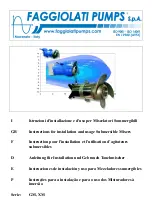
10
AM442D/AM642D
Master Section
35. AUX Return Controls
These controls adjust the signal level of audio fed
through to the stereo AUX Return inputs. The “To AUX
1” control adjusts the pre-fader level of the signal from
the AUX Return inputs to the AUX 1 mixing buses.
36. EFX Return (AUX Return 2) Control
This control adjusts the signal level of audio fed
through to stereo AUX Return 2 inputs. If no device
is plugged into the AUX Return 2 inputs, this control
then acts as the final level control of the built-in Digital
Effect Engine.
37. Main L/R and Group 1-2 Buttons
The EFX Return control on the AM442D is
accompanied by a Main L/R / Group 1-2 button. In
the case of the AM642, there are 2 buttons: one for
Main L/R and one for Group 1-2, both of which can
be used simultaneously. In both cases, however,
these buttons change the destination of the EFX
Return signal between the Main L/R signal and/or
Group 1-2 sub mix.
38. Return Solo Buttons (AM642D)
Pushing either of the AM642D’s Return Solo buttons
allows users to send the signal from the AUX Returns
1 and/or 2 to the Control Room / Phones mixing
bus.
39. AUX Send Master Control
This control adjusts the final level of the AUX mixing
bus (as taken from the AUX level controls on each
channel strip), the audio of which is sent to AUX Send
output. The corresponding SOLO button allows you
to send the AUX Send signal to the Control Room /
Phones mixing bus. The AM 642D features 3 sends,
where the first is in fact a 60mm fader, rather than
the simple rotary control. Also incorporated with the
AUX 1 control of the AM 642D is a Peak LED, as
well as an ON button and indicator, allowing AUX 1
to be activated and muted when required. Activation
of AUX Send 1 is, of course, accompanied by an
illuminated LED.
40. EFX Send Master Control
This control adjusts the final level of the EFX mixing
bus (as taken from the EFX level controls on each
channel strip), the audio of which is sent to the AUX
Send 2 (on the AM 442D) or the AUX Send 3 (on
the AM 642D) outputs, as well as the built-in digital
effect engine. The corresponding SOLO button allows
you to send the signal to the Control Room / Phones
mixing bus.
41. Control Room / Phones Controls
This control is used to adjust the audio level of the
Phones feed, as well as the signal sent to the Control
Room output, for use in monitoring and tracking of
audio.
Priority
Signal
Highest
From Solo
Medium
2T Return to Control Room
Lowest
Main L/R
42. Pre / Post Control
This button alternates the Control Room / Phones
source signals between those of post-fader and
pre-fader feeds.











































